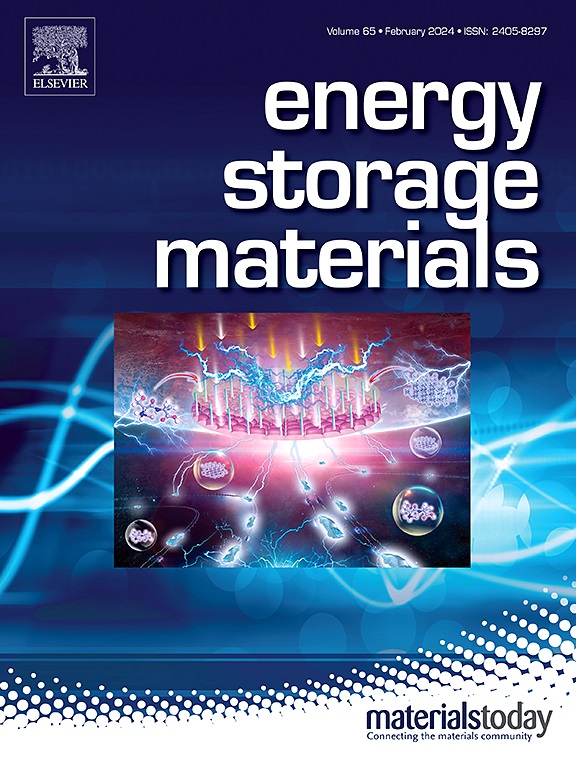Strong association dual lithium salts for ether-based electrolyte enable 4.5 V high-voltage lithium metal battery
IF 18.9
1区 材料科学
Q1 CHEMISTRY, PHYSICAL
引用次数: 0
Abstract
To achieve a battery system with an high energy density, it is crucial to utilize a highly reversible lithium metal anode and a high-voltage cathode. However, conventional electrolytes usually exhibit insufficient thermodynamic stability, leading to aggressive lithium dendrites growth and severe cathode-electrolyte reactions, particularly at high voltage (≥ 4.5 V vs. Li/Li+). Herein, we propose a design strategy for a strong association electrolyte (SAE) that reduces Li+-solvent coordination number, facilitating the formation of ion pairs or ion clusters, even with conventional lithium salt concentrations (1 M). Lithium salts with high cluster formation constant (KA), such as lithium difluorophosphate (LiDFP) and lithium nitrate (LiNO3), create an SAE with anion-dominated solvation structure, which promotes the formation of aggregates (AGGs) solvate species. This unique solvation structure facilitates the formation of a dense, inorgain rich solid electrolyte interphase (SEI) on lithium metal anode. Additionally, the preferential adsorption of anion clusters at the cathode interface constructs a Li+-anions enriched double electric layer (EDL), stabilizing the LiNi0.8Co0.1Mn0.1O2 (NCM811) interface. The Li||NCM811 batteries with a 4.5 V high cut-off voltage achieved stable cycling over 1400 cycles with a capacity retention rate of 84 %. Furthermore, 2.5 Ah pouch cells demonstrate superior cycle performance at 4.3 V cut-off voltage and 0.6 A/3 A charge/discharge currents. These findings present a straightforward electrolyte design strategy that contrasts with conventional approaches, which typically rely on increasing salt concentration or introducing complex additives, to promote the practical applications of high energy density lithium metal batteries (LMBs).

强缔合双锂盐醚基电解质实现4.5 V高压锂金属电池
为了实现具有高能量密度的电池系统,利用高度可逆的锂金属阳极和高压阴极至关重要。然而,传统的电解质通常表现出热力学稳定性不足,导致侵略性的锂枝晶生长和严重的阴极-电解质反应,特别是在高压下(≥4.5 V vs. Li/Li+)。在此,我们提出了一种强缔合电解质(SAE)的设计策略,即使在常规锂盐浓度(1 M)下,也能降低Li+-溶剂配位数,促进离子对或离子簇的形成。具有高簇形成常数(KA)的锂盐,如二氟磷酸锂(LiDFP)和硝酸锂(LiNO3),可以形成阴离子为主的溶剂化结构的SAE,促进聚集体(AGGs)溶剂化物的形成。这种独特的溶剂化结构有助于在锂金属阳极上形成致密的、富含无机的固体电解质界面(SEI)。此外,阴离子团簇在阴极界面的优先吸附构建了Li+-阴离子富集的双电层(EDL),稳定了LiNi0.8Co0.1Mn0.1O2 (NCM811)界面。具有4.5 V高截止电压的Li||NCM811电池在1400次循环中稳定循环,容量保持率为84%。此外,2.5 Ah袋状电池在4.3 V截止电压和0.6 A/3 A充放电电流下表现出优异的循环性能。这些发现提出了一种简单的电解质设计策略,与传统方法相比,传统方法通常依赖于增加盐浓度或引入复杂的添加剂,以促进高能量密度锂金属电池(lmb)的实际应用。
本文章由计算机程序翻译,如有差异,请以英文原文为准。
求助全文
约1分钟内获得全文
求助全文
来源期刊

Energy Storage Materials
Materials Science-General Materials Science
CiteScore
33.00
自引率
5.90%
发文量
652
审稿时长
27 days
期刊介绍:
Energy Storage Materials is a global interdisciplinary journal dedicated to sharing scientific and technological advancements in materials and devices for advanced energy storage and related energy conversion, such as in metal-O2 batteries. The journal features comprehensive research articles, including full papers and short communications, as well as authoritative feature articles and reviews by leading experts in the field.
Energy Storage Materials covers a wide range of topics, including the synthesis, fabrication, structure, properties, performance, and technological applications of energy storage materials. Additionally, the journal explores strategies, policies, and developments in the field of energy storage materials and devices for sustainable energy.
Published papers are selected based on their scientific and technological significance, their ability to provide valuable new knowledge, and their relevance to the international research community.
 求助内容:
求助内容: 应助结果提醒方式:
应助结果提醒方式:


